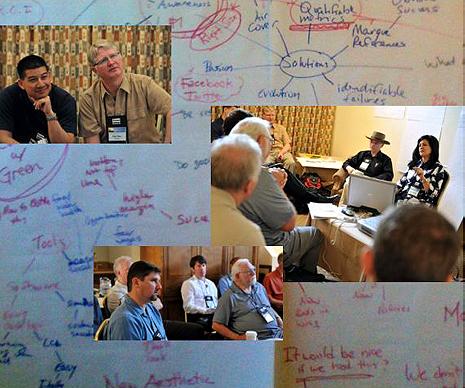

When I converse with colleagues passionate about sustainable design, I frequently hear frustration concerning the lack of tools that might help us better understand the impacts of our design decisions. This frustration is amplified by urgency – a sense that we are running out of time and could have used these tools yesterday!
Yet software vendors tell us that only 1% of their customers demand software for the purpose of sustainable design, making it difficult to prioritize the development of sustainable performance software. That’s a true sustainability paradox; we need users demanding this software providing feedback on how to improve it, but it’s slow out of the gate reaching a critical mass of users until Sustainable Performance Software congeals in our industry.
The DaS (Design and Sustainability) Symposium [2], an exploratory group representing a broad cross-section of the design industries – including architecture, engineering and construction (AEC) and manufacturing – was founded to address this paradox and other questions of design and sustainability.
The goal of the DaS Symposium is to define the needs and opportunities for an emerging category -- Sustainability Performance Software [3]. We hope to tighten the feedback loop between users and vendors and look for collaborative opportunities for normally competitive vendors and users. The point is to empower companies to succeed with Sustainability Performance Software.
We convened the first DaS Symposium April 16-18 in Scottsdale, Arizona. The Symposium was co-located in the annual COFES meeting (Congress on the Future of Engineering Software) and benefitted significantly from the networking and keynote speeches that take place each year at COFES. The first day, we heard presentations and engaged in discussions on sustainable design and software topics. On day two, we brainstormed the challenges and opportunities – always returning the focus to what our next actions should be.
Few challenges outweigh gathering a group of minds into a room and collectively making decisions- especially when considering complex messy issues such as the economy, environment and society. This is doubly difficult in the context of sustainability – a very difficult topic to put boundaries on! Sustainability is both an intensely personal and profoundly civic topic with untold ramifications for our futures.

One of the primary goals of the first DaS Symposium was simply to gather diverse people representing multiple points of view to discuss and learn from each other. We were careful not to presuppose an outcome, although we hoped to answer an important question – was there an authentic need to re-convene and take further action?
We reached consensus on the following topics:
We still have a lot to figure out. For example, why do software vendors report that only 1% of their customers demand sustainability performance software? What is the best mechanism to provide vendors with actionable input about the needs of design teams working to design more sustainably? And if vendors build software enabling designers to better understand the impacts of their design decisions, will designers use the software if customers and clients are not demanding it? Finally, we are left asking, “Should the education of designers, consumers, clients, and software architects and executives be our top priority?”
The DaS Symposium was a unique opportunity to step back and look at the whole system from multiple perspectives. We created time to collaborate and discuss how to leverage our network to help tip the design and software industry into Sustainability Performance Software.
I came away with the notion that as software becomes the foundation of our civilization, excellent information management and software tools will be a cornerstone of our sustainable future. To be specific, I am referring to simulation of sustainable buildings, cities and products with metrics, indicators, lifecycle analysis, ecosystems analysis, construction cost, operations cost and lifecycle cost analysis along with decision support systems to best inform designers of sustainable ecosystems.
More importantly, the DaS Symposium inspired optimism that collaboration is the face of sustainability. In keeping with that spirit, we plan to meet quarterly on a virtual basis and look forward to re-convening in-person at The DaS Symposium next April.
I welcome any comments and/or questions on this important topic. Please respond in the comment box below. I’ll be sure to respond quickly to any comments here. To repeat the message in my open, we’re running out of time!”
Links:
[1] http://www.sustainableminds.com/files/images/blog/090522_kh_1.jpg
[2] http://cofes.com/Events/COFES2009/TheDaSSymposium/tabid/497/Default.aspx
[3] http://www.sustainableminds.com/blog/sustainability-performance-software-–-emerging-sector